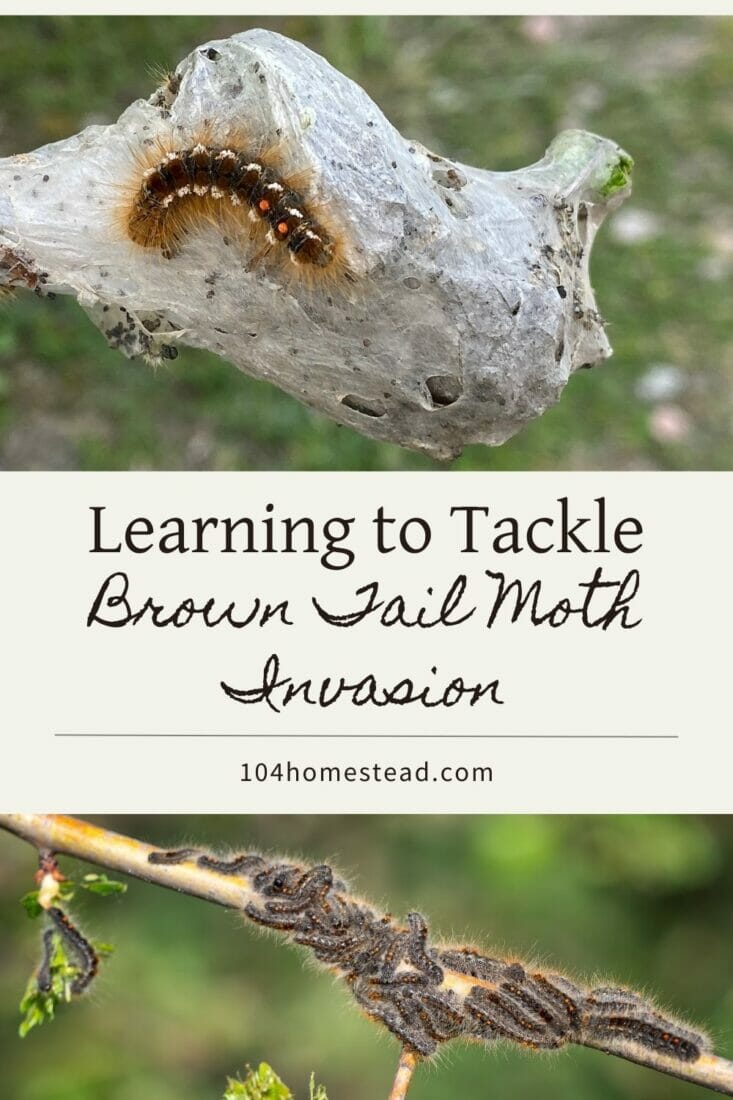Conquer the Brown Tail Moth: Tips to Combat Invasive Species
Learn how to tackle the brown tail moth. Understanding the nature of the infestation, identifying and removing nests, and natural remedies.
Estimated reading time: 10 minutes
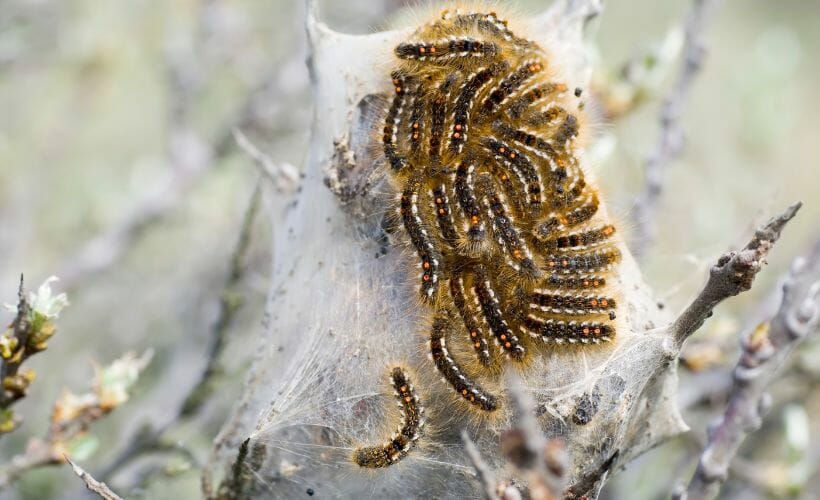
It has finally happened. The brown tail moth has made it to my part of Maine. They used to be located along the Maine coast, but they’ve moved inland. Maybe it’s the unusually warm spring we’ve had. Maybe it’s all the rain. Either way, I have an ornamental shrub that is absolutely covered. Because these moths kill trees and are a serious human health concern, they have to be dealt with. Normally I’m a Neem Oil girl, but these guys came to play. But fear not! I will show you how to deal with this invasive species as best as we can. From understanding the culprit behind the infestation to safe nest removal techniques and natural remedies, I’ve got you covered. Say goodbye to harmful chemicals and take control of your homestead once and for all.
Understanding the Brown Tail Moth
To effectively combat the brown tail moth outbreak, it is crucial to understand the nature and behavior of these pests. Originally native to Europe, the brown tail moth has established itself in various parts of North America, including the northeastern United States. These moths are primarily active during June, July, and August, with females laying eggs that hatch into caterpillars. These caterpillars are the true culprits behind the nightmare, as they feed on foliage and build their nests in trees, shrubs, and even the eaves of houses.
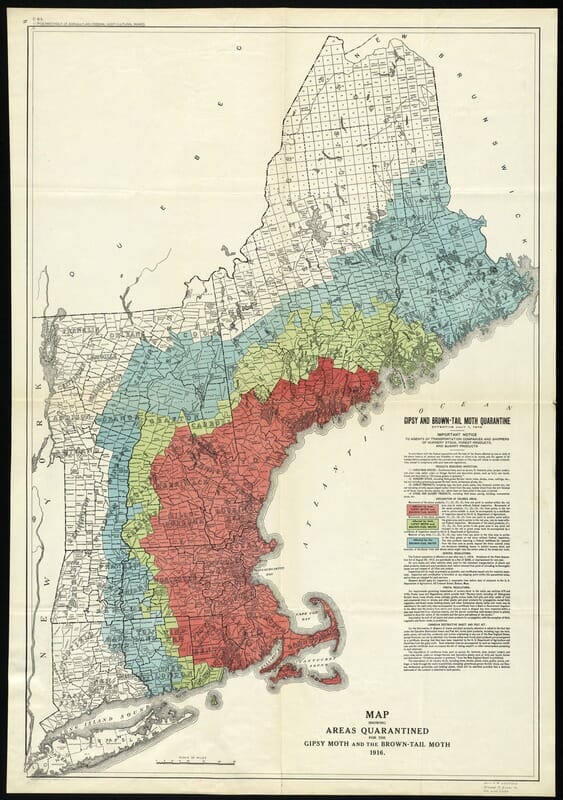
The Maine Forest Service is doing its absolute best to guide residents on dealing with these moths and caterpillars, but their appearance in the area is still relatively new. A lot of research is still needed to get control of the situation.
Identifying Brown Tail Moth Nests
One of the first steps in tackling brown tail moths is identifying their nests. They are typically found in shaded areas, such as the undersides of leaves or along the branches of trees. They are distinctive in appearance, resembling a grayish-brown mass, usually located at the tips of branches or near the trunk. The nests are composed of silk and are often accompanied by the presence of caterpillars and their telltale hairs.
Understanding the Life Cycle
By familiarizing yourself with the life cycle of the brown tail moth, you can better anticipate and address infestations. After the eggs hatch, the caterpillars go through several growth stages, molting their skin until they reach their final instar. Fully grown caterpillars are about one inch long and have a distinct pattern of white dots along their back. It is during this stage that the caterpillars become more noticeable and destructive, stripping leaves and causing defoliation. My shrubs haven’t reached this period yet, but I expect it any day now.
Health Risks and Allergic Reactions
It’s important to note that the brown tail moth caterpillar poses health risks to humans. The caterpillars’ hairs can cause allergic reactions, with symptoms including skin rashes similar in appearance to a poison ivy rash, respiratory issues, and even eye irritation. These toxic hairs can become airborne and spread through the wind, leading to potential exposure even if you’re not in direct contact with the caterpillars or their nests. Because the infected shrubs on my homestead are located just outside my bedroom window, this is more than a little concerning.
Taking preventative measures, such as wearing protective clothing and gloves when handling potentially infested areas, can help minimize your risk of exposure. Additionally, regularly inspecting your surroundings and promptly removing any nests or caterpillars can prevent further spread and reduce the likelihood of experiencing allergic reactions. These inspections might get overlooked when you’ve been stuck inside due to near-monsoon rains for two months. Yes, it’s me. I’m talking about me.
Identifying Brown Tail Moth Nests
By familiarizing yourself with the distinct characteristics of brown tail moth nests, you can quickly spot them and take immediate action to prevent further infestation.
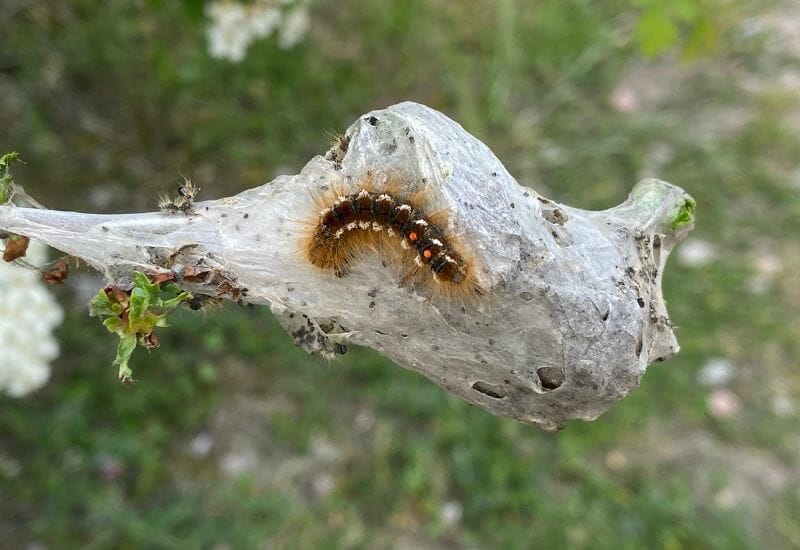
One of the key features is their appearance. They are typically constructed using a combination of silk, foliage, and hair from the caterpillars themselves. They are often small and can vary in color, ranging from white to light brown, and are usually found in the nooks and crannies of trees, shrubs, and buildings. Keep an eye out for tightly woven clusters of silk that resemble small cocoons. They prefer oak, apple, crabapple, pear, birch, cherry trees, and other hardwoods but can be found on almost any tree or shrub.
Another way to identify brown tail moth nests is by observing the behavior of the caterpillars. These pests tend to congregate near their nests, so if you notice a large number of caterpillars in a particular area, there is a good chance of a nest nearby. Additionally, the presence of silky webbing on branches or foliage is a telltale sign that a nest is nearby.
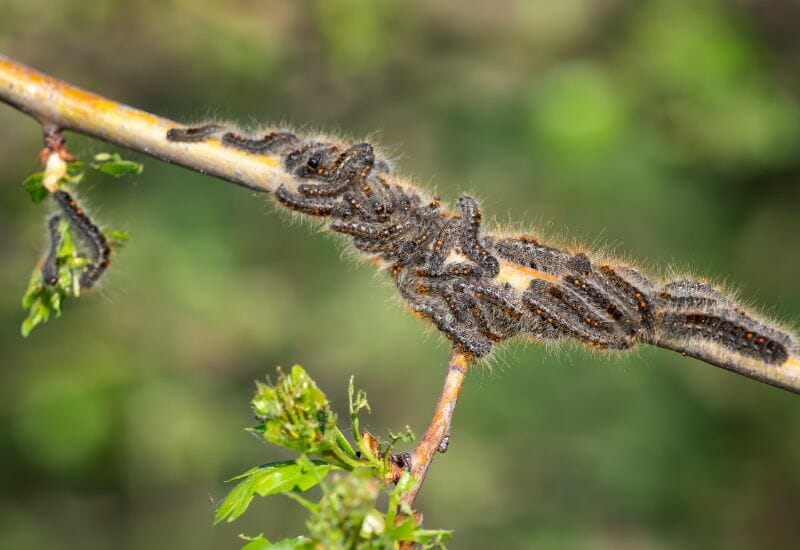
In addition to wearing protective clothing, gloves, and a mask, it is also recommended to use a long-handled tool, such as a broom or rake, to remove the nest from its location safely.
Protecting Trees from Brown Tail Moths
Now that you understand the importance of safely removing brown tail moth nests, it’s time to explore effective techniques to help you tackle this problem head-on. In the upcoming section, we will delve into proven strategies for protecting your trees from brown tail moths. By combining this knowledge with proper removal, you’ll have a comprehensive plan in place to combat these invasive insects and safeguard your homestead.
One of the most effective strategies is to begin monitoring your trees early in the season. Regularly inspect your trees for the brown tail moth caterpillars’ nests.
Another important step in protecting your trees is to keep them healthy and strong. Well-maintained trees are more resilient to pests, including brown tail moths. Ensure your trees receive proper watering, nutrients, and pruning to enhance their overall vitality. Additionally, removing dead or diseased branches can help minimize hiding places for brown tail moths and reduce their chances of establishing nests.
Enlisting the help of the forestry department, professional arborists, or pest control specialists can provide an extra layer of protection for your trees. These experts have extensive knowledge and experience in dealing with brown tail moths. They can provide targeted treatments, such as spraying insecticides on affected trees, to control the population and prevent further damage effectively. I know we tend to be anti-chemical, but there are organic options available, and sometimes you need to take the plunge and bring out the real deal heavy-duty treatments for the greater good.
Natural Remedies to Combat Brown Tail Moths
While enlisting professional help is a reliable approach, there are also natural remedies that can help combat the brown tail moth. These remedies are not only effective but also environmentally friendly, making them a popular choice among homesteaders who prefer a more natural approach to pest control.
Using Bt var. Kurstaki
One natural remedy that has shown promise in combating brown tail moths on our homestead is using Bacillus thuringiensis (Bt) var. kurstaki. This naturally occurring bacterium produces proteins that are toxic to the caterpillars of the brown tail moth. When sprayed on affected trees, Bt var. kurstaki can effectively target and eliminate these invasive pests, without harming other beneficial insects or causing harm to the environment. Because my big vegetable garden is relatively close to our infected area, this is the route I prefer to take.
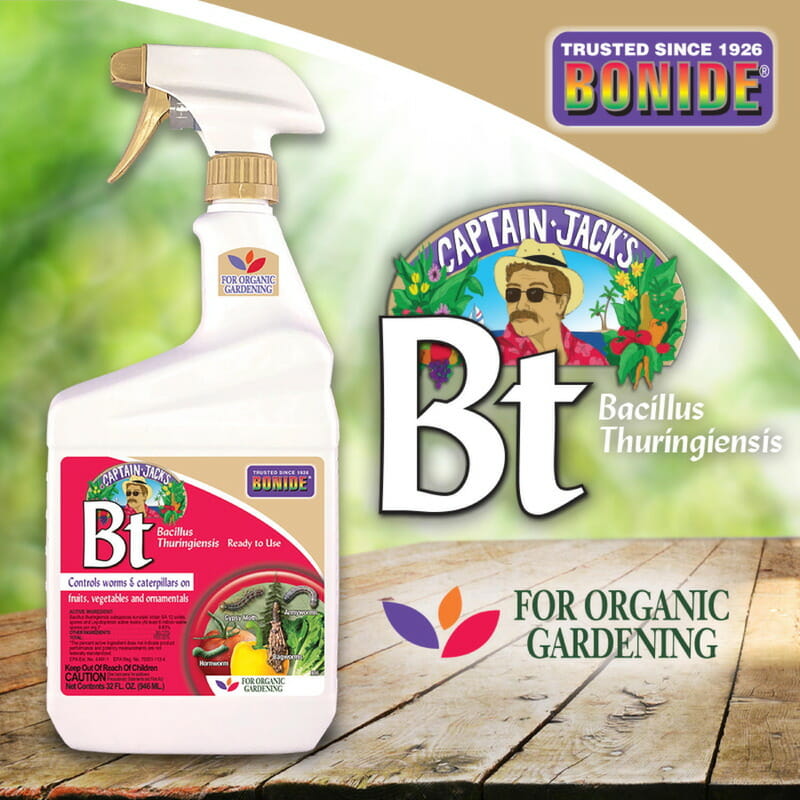
Using Sticky Bands or Tree Wraps
Another natural remedy to consider is using sticky bands or tree wraps. These simple yet effective tools act as physical barriers, preventing adult male moths from climbing up the trunk of the trees and mating with the females. By disrupting their mating process, you can significantly reduce the number of eggs being laid on your trees, thus limiting their numbers. Applying these sticky bands or wraps during the winter months or in the early spring, before the adult moths become active, can be particularly effective.
Encouraging Natural Predators
In addition to these remedies, encouraging natural predators of the brown tail moth can also help control their population. Birds such as bluetits, chickadees, and nuthatches are known to feed on brown tail moth caterpillars. Attracting these birds to your outdoor spaces by providing birdhouses, feeders, and bird baths can create a natural balance and reduce the impact of the caterpillars. Chickens, ducks, and guineas can also cut down the caterpillar population if you pen them in the area or allow them to free range.
Some FAQs Regarding the Brown Tail Moth
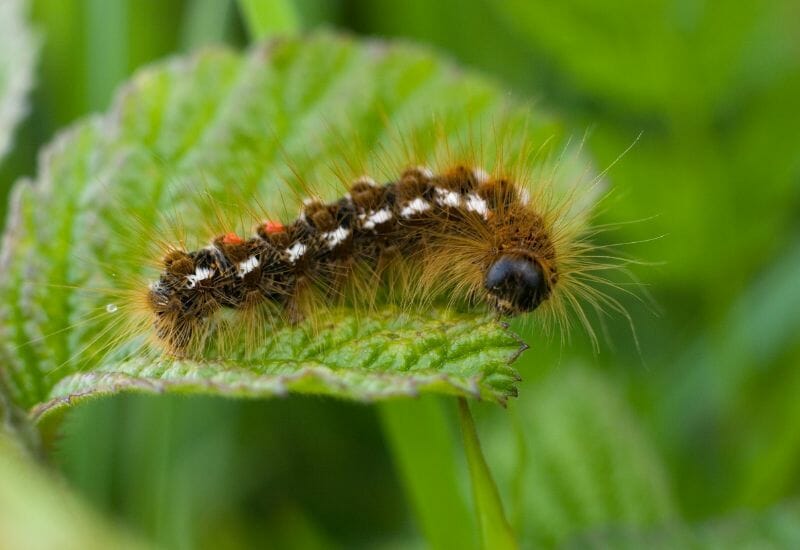
How long does brown tail moth season last?
Brown tail moth season typically lasts from late spring to mid-summer, which is roughly May through July.
Is it OK to burn brown tail moth nests?
Whether it is ok to burn brown tail moth nests depends on several factors, such as local regulations, potential risks, and environmental impact. First, it is necessary to check with local wildlife agencies or pest control services, as some areas may prohibit interference with wildlife. Second, it could pose a fire risk depending on the location of the nests and the conditions. Lastly, the environmental impact should be taken into consideration. Burning nests may damage the ecosystems where these moths are a part. Therefore, you should turn to professionals who can help you decide on the most effective and safe approach.
How long are brown tail moth hairs toxic?
Brown tail moth hairs retain their toxicity for up to three years.
Can you wash off brown tail moth hairs?
Yes, it is possible to wash off brown tail moth hairs from your skin. Washing the affected area with soap and water thoroughly is highly recommended. However, this may not completely alleviate the itchiness and irritation caused by the hairs, as they release a toxin that can cause skin inflammation. You may also need over-the-counter creams or oral antihistamines to help manage symptoms. If severe reactions occur, such as difficulty breathing or swelling, it’s crucial to seek medical attention immediately.
Can brown tail moth hairs stay in clothes?
Yes, brown tail moth hairs can potentially stay in clothes. The microscopic barbs on the hairs can attach to fabric, making them difficult to remove. Washing and drying clothes may not entirely get rid of these hairs. Handling these clothing items cautiously is advisable to avoid any potential skin irritation or allergic reactions.
How long does brown moth rash last?
The duration of a brown moth rash varies from person to person. It can last anywhere from a few hours to several weeks, depending on the individual’s sensitivity to the moth’s scales or hairs, the extent of exposure, and their immune response. Individuals with more severe reactions may require medical treatment, which could also affect the duration of the rash. It is advised to consult a healthcare professional for a more accurate diagnosis and treatment plan.
How do you get rid of brown tail moth itching?
To alleviate brown tail moth itching, avoid direct contact with these moths as much as possible. If contact happens, immediately wash the area with soap and cold water to remove any potential caterpillar hairs. You can also use tape to lift any remaining hairs off your skin. Over-the-counter itch relief creams, antihistamine tablets (like Benedryl), or lotions can help to control itching. If the rash persists or worsens, it is best to consult a healthcare professional for further guidance. In case of eye irritation, seek immediate medical attention. Remember, prevention is better than cure, so try to wear protective clothing when you are in areas where these moths are prevalent.
The brown tail moth nightmare can be conquered or, at the very least, minimized with these strategies. By understanding the nature of the infestation, identifying and safely removing nests, protecting your trees, and utilizing natural remedies, you can reclaim your living spaces from these pesky pests. Take the first step today and say goodbye to the brown tail moth nightmare.
